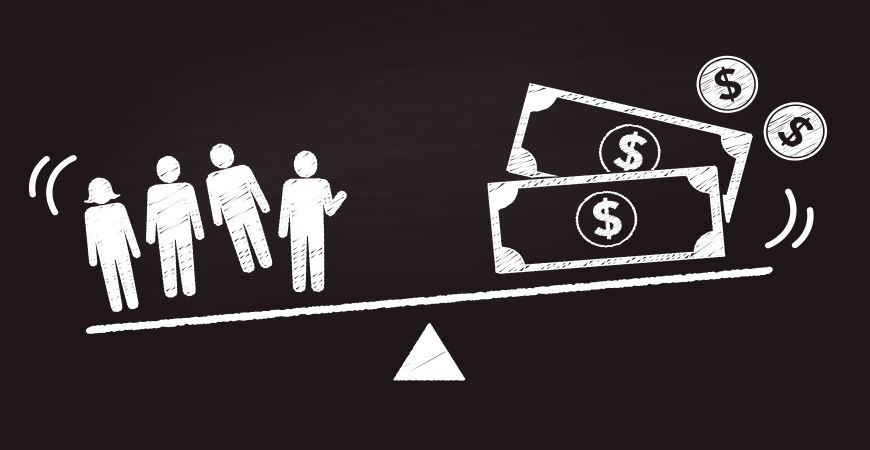This website uses cookies so that we can provide you with the best user experience possible. Cookie information is stored in your browser and performs functions such as recognising you when you return to our website and helping our team to understand which sections of the website you find most interesting and useful.
New research finds discriminatory personalised pricing is a global problem

Consumers International and Mozilla Foundation investigation finds price discrimination on Tinder in six different countries
A new report from Consumers International has found that personalised pricing is not being implemented fairly, transparently or with proper oversight. Euroconsumers support Consumers International in calling for more awareness and action on this potentially discriminatory practice.
What is personalised pricing?
Personalised pricing is a potentially discriminatory practice where prices are set at a different level for each individual consumer, based on an assessment of what they are willing and able to pay.
Consumers paying different prices for the same product is of course nothing new – different stores will have their own mark-ups, or costs might rise as scarcity increases. In a competitive market we expect some level of price differentiation and personalised pricing is not inherently harmful to consumers.
However, the data-driven personalisation of prices has expanded the practice into new and potentially harmful territory. Companies can now make use of advanced data collection, machine learning algorithms and the ability to make real-time offers to sharpen their personalised pricing – techniques that are invisible to consumers.
Consumers double disadvantaged by hidden pricing
This puts consumers at a double disadvantage – firstly being targeted based on sophisticated analysis of their likely behaviour by a company, and secondly being unable to compare prices and shop around for a better deal. The end of any kind of standard or expected pricing is highly significant for consumer markets and is almost impossible to spot on an individual level.
Despite the potential implications of this practice, there is limited publicly available research on the extent to which personalised pricing is currently in use, and on what it means for consumer protection. New research from Consumers International aims to change this, with a study of consumer concerns about discriminatory personalised pricing and an investigation into the practice.
Investigation finds hidden and unfair personalised pricing in dating app
Consumers International new report, co-produced with the Mozilla Foundation, presents the findings from a study into the prevalence of personalised pricing in dating services across New Zealand, the USA, the Netherlands, the Republic of Korea, India and Brazil. They selected Tinder as a case study as it offered a similar service across these different countries.
The research asked around 100 participants from each country, encompassing a range of different demographics and characteristics, to take part in a mystery shopping exercise on the paid-for version of the app. The participants shared the monthly price they were offered for the Tinder Plus service after entering their name, age, gender, and sexual preference, and after sharing their location data. Key findings include:
- Unfair pricing is occurring on Tinder Plus: In five of the six countries surveyed, people aged 30-49 and 50+ were quoted substantially more on average than those aged 18-29. On average across the six countries, 30-49 year-olds were charged 65.3% more than 18-29 year-olds. These pricing differences persist even after Tinder faced a $24 million lawsuit for unfair pricing based on age in California.
- Price differentials are high: In the Netherlands, consumers were quoted 31 unique price points. In some cases, the difference between highest and lowest prices was over 450%. In the Netherlands, prices ranged from $4.45 to $25.95 (USD). In the U.S., they ranged from $4.99 to $26.99.
- Personalised pricing is opaque: Consumers are offered minimal transparency at the point of purchase on the use of personalised pricing, with unclear references to ‘promotional rates’ and ‘offers and discounts tailored to your profile’ buried deep within Tinder’s terms of use. Tinder’s price-setting mechanism is drawing on age and likely other unknown factors, possibly including data points beyond those provided upon registration.
The participants were also surveyed to understand their level of concern, and almost everyone of respondents (97%) registered some level of concern about personalised pricing, with a lack of transparency and potential for unfairness identified as greatest risks.
How is personalised pricing regulated?
The study concluded that in many cases, the necessary legislation already appears to be in place to tackle discriminatory pricing, but is not being enforced. In terms of regulation that’s relevant to the EU we have:
Unfair commercial practices: Marketing practices such as online price discrimination, dynamic pricing and personalised pricing fall under Directive 2005/29/EC on unfair commercial practices. The updated European Commission Guidance Notice on the Unfair Commercial Practice Directive allows personalised prices based on online tracking and profiling, but requires traders must inform consumers of how that price was decided. The Directive also recognises that personalised pricing and offers may be combined with other unfair commercial practices such as aggressive marketing to create bigger disadvantages for consumers.
Privacy and data protection: Whilst privacy and data protection laws cannot directly regulate business pricing decisions, the GDPR governs the collection, storage, and processing of the personal data, which is often used to implement personalised pricing. Under the GDPR, the use of personal data (including internet identifiers) to tailor a price to an individual must comply with the fundamental principles of transparency, fairness, and lawfulness. Legal scholars have argued that this is not the case at present, and that many examples of personalised pricing are likely in breach of these rules.
The GDPR also contains specific regulations relating to certain profiling and automated decision-making activities. However, personalised pricing is only likely to fall within the scope of such regulations in limited cases with significant potential for consumer harm, such as medical cases where treatment may not be affordable.
Geographical discrimination: European Union law protects consumers against price discrimination on the basis of their nationality or place of residence under laws regarding ‘geo-blocking’ set in 2006.
What can be done?
Consumers International make three core recommendations as a first step in tackling the challenge of personalised pricing:
- Transparency and the right to information: businesses must make it clear to consumers when and how personalised pricing is being used and governments and regulators must establish and enforce this.
- Consumer protection and empowerment: give consumers greater agency over the use and dissemination of their personal data collected for personalised pricing purposes, and introduce measures to uphold data protections for all.
- Equality and anti-discrimination: businesses to ensure that personalised pricing does not violate anti-discrimination law, and provide transparency for pricing practices to be investigated and audited.
These recommendations align with the core message of Euroconsumers My Data is Mine manifesto that consumers need to be empowered to use their data on their terms, and not have it used against them in opaque ways. Respect and transparency are key, otherwise trust in digital services will diminish, hampering mutually beneficial relationships and innovation.
As a cross-border issue, discriminatory pricing needs to be tackled by global action and Euroconsumers is in a strong position to support Consumers International as it takes on the challenge. Along with our international partners, we are committed to monitoring personalised pricing to fill the evidence gap, and understand the mechanics of the process and the impact on consumer rights and welfare better. It’s a practice that is hard to spot and not yet too widely employed, but consumers are worried and rightly so. We are keeping watch.


